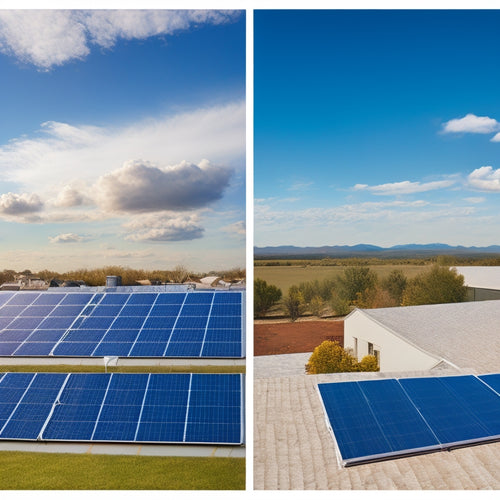
3 Essential Tools for Renewable Energy Integration
Share
You're poised to accelerate the shift to renewable energy-based grids, and three essential tools are critical to success. First, streamlining energy storage operations guarantees effective grid balancing and optimized battery maintenance. Next, optimizing solar power distribution integrates solar power into the grid efficiently, achieving grid parity for cost-effective energy. Finally, advanced analytics for energy management provides real-time insights, enabling data-driven decisions and predictive modeling for energy demand and supply. By integrating these tools, you'll be able to facilitate a smooth shift to renewable energy - and exploring these concepts further will reveal even more opportunities for innovation.
Key Takeaways
• Advanced monitoring and control systems optimize energy storage operations, reducing costs and improving efficiency.
• Optimized solar power distribution ensures maximum efficiency and reliability in transmitting generated energy to consumption points.
• Advanced analytics provide real-time insights into energy management, enabling predictive modeling and forecasting energy demand and supply.
• Effective grid balancing is achieved through advanced monitoring and control systems, stabilizing energy supply in renewable energy systems.
• Predictive modeling and real-time tracking enable adjustments to energy production and consumption, increasing efficiency and optimizing renewable energy systems.
Streamlining Energy Storage Operations
By implementing advanced monitoring and control systems, you can greatly reduce energy storage operation costs and improve overall efficiency. This is achieved by optimizing battery maintenance, a critical aspect of energy storage operations. With advanced monitoring, you can detect potential issues before they become major problems, reducing downtime and extending the lifespan of your batteries.
This proactive approach to battery maintenance enables you to schedule maintenance during off-peak hours, minimizing the impact on grid operations.
Effective grid balancing is another essential aspect of streamlining energy storage operations. By leveraging advanced monitoring and control systems, you can ensure that your energy storage systems are optimized to provide grid stability and balance.
This is particularly important in renewable energy systems, where output can vary depending on weather conditions. By integrating advanced monitoring and control systems, you can ensure a stable and efficient energy supply, even in the face of variable renewable energy output.
Optimizing Solar Power Distribution
As you integrate solar power into the grid, optimizing its distribution becomes vital to guarantee maximum efficiency and reliability. You need to make sure that the energy generated is efficiently transmitted to the point of consumption. One key aspect of optimizing solar power distribution is inverter sizing. Proper inverter sizing ensures that the DC power from the solar panels is efficiently converted to AC power, minimizing energy losses.
| Inverter Size | Efficiency | Cost |
|---|---|---|
| Undersized | Low | Low |
| Oversized | High | High |
| Optimized | High | Medium |
Achieving grid parity, where the cost of solar energy is equal to or less than traditional fossil fuels, is a critical milestone in the adoption of renewable energy. Optimizing solar power distribution is essential to reach this goal. By selecting the right inverter size and optimizing the distribution of solar power, you can reduce energy losses, increase efficiency, and ultimately reduce the cost of solar energy. This, in turn, helps to accelerate the shift to a renewable energy-based grid.
Advanced Analytics for Energy Management
With the optimized distribution of solar power in place, you can now leverage advanced analytics to gain real-time insights into energy management, enabling data-driven decisions that further optimize your renewable energy integration.
Advanced analytics plays an essential role in energy management by providing predictive modeling capabilities, which enable you to forecast energy demand and supply. This allows you to adjust your energy production and consumption accordingly, reducing waste and increasing efficiency.
Real-time monitoring is also a key aspect of advanced analytics, enabling you to track energy production and consumption in real-time. This allows you to identify areas of inefficiency and make adjustments on the fly, ensuring that your renewable energy system is running at peak performance.
Frequently Asked Questions
How Do I Select the Most Suitable Energy Storage System for My Needs?
You'll want to start by conducting energy audits to determine your energy needs, then perform system sizing to identify the ideal energy storage system capacity, ensuring you select the most suitable solution for your specific requirements.
What Are the Benefits of Using Microgrids for Renewable Energy Integration?
"Can you imagine having uninterrupted power supply, no matter what? With microgrids, you get Microgrid Resilience, ensuring energy availability during outages. Plus, you'll enjoy Energy Autonomy, making you less dependent on the grid, and more in control of your energy future."
Can Renewable Energy Sources Power My Entire Community Independently?
You can achieve community-scale energy autonomy by combining multiple renewable sources, energy storage, and smart grids, enabling your community to independently power itself, reducing reliance on external grids and enhancing energy security.
How Do I Ensure Grid Stability With High Renewable Energy Penetration?
To maintain high renewable energy penetration, you'll need to guarantee grid stability by implementing Frequency Regulation strategies to sustain a stable 50/60 Hz frequency, and monitor Power Quality to prevent voltage fluctuations and harmonic distortions.
What Are the Most Promising Emerging Renewable Energy Technologies?
As you explore the renewable energy landscape, you'll stumble upon tidal power, harnessing ocean tides to generate electricity, and advanced bioenergy systems, converting organic matter into energy, both promising emerging technologies that might just revolutionize the industry.
Related Posts
-

Top 7 Portable Solar Car Battery Solutions Online
You're in luck with our selection of reliable portable solar car battery solutions that meet your needs and budget. O...
-

What Makes a Road Bike-Friendly by Design?
As you plan and design roads, incorporating features like dedicated bike lanes, smooth surfaces, and traffic calming ...
-

Tracking Solar Panels Vs Fixed Panels Cost Savings
When considering solar panel options, you'll want to weigh the cost savings of tracking solar panels versus fixed pan...


